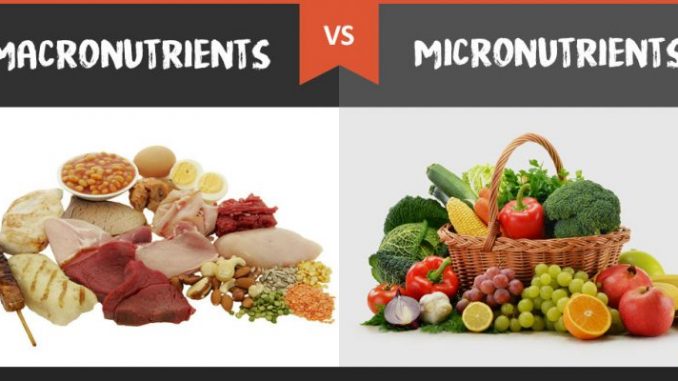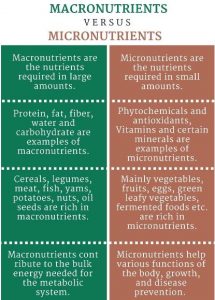
Before moving on to the major differences between macro-nutrients and micro-nutrients, let us take a simple overview of what nutrients are:
- Nutrients are the organic substances present in the food and used by the body for the maintenance of life and growth.
- Generally, there are six categories of nutrients required for healthy living; carbohydrates, protein, fats, vitamins, mineral, and water.
- Based on metabolic effects nutrients are categorized into macro-nutrients and micro-nutrients.

Table of Contents
What are macro-nutrients?
- Macro-nutrients are composed of two words i.e. Macro and Nutrients.
- “Macro” means in large scale whereas “nutrients” are the chemical substance required by the body.
- Therefore, macro-nutrients are the chemical substances required by our body in large quantities on a daily basis for the proper functioning of the body that includes carbohydrates, proteins, fats, and water. Each of them provides energy in the form of calories.
What are micro-nutrients?
- ‘Micro’ means small.
- Micro-nutrients are the organic substances required by the body in small quantities or diminutive compared to macro-nutrients.
- In simple terms, vitamins can be water-soluble vitamins, fat-soluble vitamins and minerals can be macro-minerals and trace minerals.

Now let us look at the major differences between Macro-nutrients and Micro-nutrients.
15 Differences between Macro-nutrients and Micro-nutrients are:
| S.N. | Difference on the basis of | Macro-nutrients | Micro-nutrients |
| 1. | Requirement | Macro-nutrients are required in larger amount/quantity on a daily basis | Micro-nutrients are required in small or tiny amount/quantity on a daily basis |
| 2. | Function | · Macro-nutrients is essential for growth, repair and develop new tissues (carbohydrates), maintain body temperature (fats), conduct nerve impulses, and regulate life process. | · Micro-nutrients support macro-nutrients to carry out bodily functions. They are also an essential component for building healthy brain, body and bones. |
| 3. | Benefits/advantages | · Macro-nutrients contribute to the bulk energy needed for the metabolic system.
· Macro-nutrients provide calories that gives energy to the body |
· Micro-nutrients contribute to body growth and disease prevention.
· Micro-nutrients comprises of high volume of antioxidants which protects the body against various diseases |
| 4. | Role | Macro-nutrients plays a vital role in the construction of body composition. | Micro-nutrients do not have any role in the construction of body composition. |
| 5. | Concentration | Macro-nutrients are available in high concentration inside the body. | Micro-nutrients are present in minute concentration inside the body. |
| 6. | Composition/known as | Macro-nutrients are also called as major elements. | Micro-nutrients are also called trace elements. |
| 7. | Food composition | Cereals, legumes, meat, fish, yams, potatoes, nuts, oilseeds are rich in macro-nutrients. | Mainly vegetables, fruits, eggs, green leafy vegetables, fermented foods are rich in micro-nutrients. |
| 8. | Types and examples | There are mainly three macro-nutrients required by the body; carbohydrate, protein and fats | Different types of micro-nutrients required by the body include vitamins, minerals and trace elements. Examples: iron, magnesium, calcium, phosphorus, zinc etc. |
| 9. | Quantity | Macro-nutrients are divided into two classes: Primary and Secondary, as they are required in large quantities. | Micro-nutrients are not classified in different types, as it is required in trace amount. |
| 10. | Composition | Primary macro-nutrients include nitrogen, phosphorus, and potassium in larger quantities.
Secondary macro-nutrients include calcium, magnesium, and sulfur in lesser quantity. |
Micro-nutrients include zinc, iron, manganese, copper, boron, molybdenum and chlorine in trace quantities. |
| 11. | Toxicity | Macro-nutrients are normally not toxic to the cell if they are present in comparatively higher concentration than in the normal level. | Micro-nutrients are toxic if present exorbitantly in the cell than the required amount. |
| 12. | Excessive ingestion | Excessive intake of micro-nutrients leads to obesity and diabetes. | Excessive consumption of micro-nutrients leads to suppressing immune function. |
| 13. | Consequences of deficiency | Deficiency of macro-nutrients causes Protein Energy Malnutrition (PEM), Kwashiorkor, marasmus etc.
|
Deficiency of micro-nutrients causes different diseases like night blindness, beriberi, scurvy, goiter etc.
|
| 14. | Consequences of overdose | Overdose of macro-nutrients causes obesity, heart diseases, diabetes and other metabolic syndromes | Overdose of micro-nutrients may harm specific organs of the body. E.g.: overdose of vitamins affect liver |
| 15. | Daily recommended requirements | · From carbohydrates: 55–75% of total energy
· From protein: 15-20% of total energy or 1g/kg body weight per day · From fats: 20-35% of total energy · From monounsaturated fats: 20% of total energy · From polyunsaturated fats: 10% of total energy · From saturated fats: 7% of total energy
|
· Vitamin A – 700 µg
· Vitamin B12 – 2.4 mg · Vitamin E – 15 mg · Vitamin C – 75 mg · Thiamine – 1 mg · Riboflavin – 1.1 mg · Niacin – 14 mg · Folate – 400 mg · Iron – 18 mg · Selenium – 55 mg · Calcium – 1000 mg
|
References and For More Information:
https://www.unicef.org/nutrition/index_iodine.html
https://www.unicef.org/nutrition/training/2.1/7.html
https://www.cdc.gov/nutrition/micronutrient-malnutrition/micronutrients/index.html
https://www.childimpact.unicef-irc.org/en/macro-micro-simulations
https://www.ewg.org/research/how-much-is-too-much/harmful-effects-excess-vitamins-and-minerals
http://www.macronutrients.net/micronutrients-vs-macronutrients/
https://slideplayer.com/slide/5952303/
https://www.healthline.com/nutrition/micronutrients#deficiencies-and-toxicities
https://pediaa.com/difference-between-macronutrients-and-micronutrients/
http://www.fao.org/elearning/Course/NFSLBC/en/story_content/external_files/Essential_Nutrients.pdf
https://study.com/academy/lesson/what-are-macronutrients-definition-functions-examples.html
https://quizlet.com/26388654/flashcards
https://pediaa.com/difference-between-macronutrients-and-micronutrients/
https://www.quora.com/How-do-you-differentiate-between-macro-and-Micronutrients